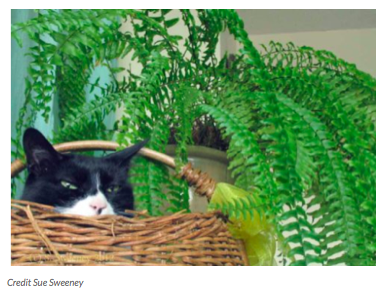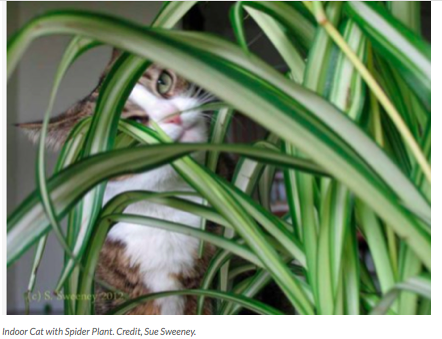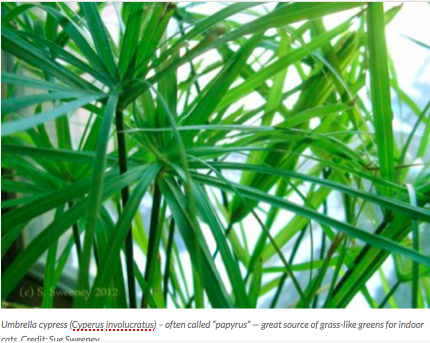By Sue Sweeney
Houseplants are good for our health, particularly in winter. They add humidity to the air and counteract some pollutants. Houseplants and cut flowers also provide welcome green and color to lift the spirits.
Equally important to our wellbeing are our companion animals; their presence can help us overcome ills ranging from high blood pressure to depression. I have, though, heard people say that you can’t have both plants and pets.
It is true that you can end up with the cat up-chucking the spider plant on the rug, but serenity doesn’t have to come at the price of sacrificing the greenery.

Know What Your Bring Home
The first and most important step is to know the identity of your plants. No matter how careful you are, one of the small beings in your care may choose to eat one of the plants. In such an emergency, having previously identified the plant can make all the difference. Many plants are sold with labels. If the plant doesn’t come labeled, ask the seller to write the name down. Keep the labels, or a list of the plant names, where you can find them quickly. If you need to look up a houseplant, The House Plant Expert by D.G. Hessayon is a good, inexpensive houseplant guide. FYI: the Connecticut Poison Control Center-Emergencies and General Information is 1-800-222-1222.
Once you know your plant’s identity, there are lists of known poisonous plants available from a variety of sources. For example, the Cat Fanciers’ Association offers an online lists of poison plants and of some of the most popular safe houseplants. Reliable information sources include poison control centers, the ASPCA, and major agricultural colleges, such as Purdue, and Cornell. Here’s some fairly technical information about poison plants from the CT Agricultural Extension Service. However, even among the best sources there is conflicting information, so it may be best to check more than one list.
Such lists, though, are only partial helpful. First, it is impossible to test, let alone list, every potential poisonous plant, so there will always be some of unknown safety. Accordingly, it is best to treat all plants as moderately poisonous unless you know them to be safe.
Second, many lists include only the plant names—they don’t specify which part of the plant may cause a problem, what the problem is, or its seriousness. You, though, may wish to know the difference between something that causes a mild skin rash after prolonged exposure and something that will shut down the respiratory system after just one bite. Look for lists that indicate which plants have high, moderate, and low toxicity ratings, and the reasons for the ratings.
Third, some advice is outdated or of dubious quality. For example, the poinsettia scare of a few years ago has fortunately proven to be unfounded. Poinsettias shouldn’t be eaten, but are no more dangerous than many other common houseplants.
Toss the Most Poisonous Plants
Once you know the identity of your plants and have acquired a reasonably reliable poisonous plants list, you can avoid plants known to be deadly; they are not worth the risk. A high toxicity rating means that the plant can be fatal even in small quantities. Oleander and the castor oil bean plant immediately come to mind.
Next, for cats, the flowers, leaves, and stems of Easter lilies and similar plants such as tiger lilies, Asian lilies, some day lilies, and the flowering houseplant glory lily (Gloriosa superba) are said to be deadly. According to both the ASPCA and the Cat Fanciers’ Association, these plants are an indoor danger to cats whether in a vase as cut flowers or in a pot. If there’s any possibility of contact, the lilies need to go.
Some examples of other highly toxic cut flowers and potted flowering plants are azalea and rhododendron, bleeding heart, foxglove, lily of the valley, red maple, (Acer rubrum), and yew. While perhaps acceptable outdoors, assuming that young children and animals are supervised, these plants are too tempting in an enclosed space. For dogs, by the way, one of the most serious dangers is the chocolate that might come with a gift of flowers.
It is also good to keep all fruit pits and seeds, and all flower bulbs out of reach. The pits of almond, peach, chokecherry, and apple, and the bulbs of amaryllis, tulip, and narcissus are known to be of concern, but why take a chance with the others?

All Babies Require Supervision
“Baby-proofing” the home and yard applies to kittens and puppies as well as to human infants. Even if the plant is known to be safe, think about related environmental hazards. Most common grasses, for example, are nontoxic, but not if the grass is growing in a lawn that has been treated with chemicals. Likewise, grass is not safe if it is growing near a road or driveway where lead or other pollutants from car exhausts may be present.
Cat-Plant Harmony Rules
Cats are carnivores and, according to many experts, don’t naturally consume vegetables other than predigested material found in prey stomachs. However, plants are a natural part of cats’ lives and they need to have access to some—but not necessarily your prize bonsai.
Because of the different lifestyles, mixing adult dogs and plants is fairly easy (sweeping tails aside), but we need a set of rules for the cats:
– Accept that cats eat houseplants.
– While cats are carnivores, they need some greens. Indoors, you are the greengrocer.
– Give your cats their own plants, and the cats will be less likely to bother your favorites.
– Cats prefer grass-types like spiders, palms (but not sago palm or the other cycads, which are poisonous), and bamboo. My cat likes a papyrus relative, umbrella sedge (Cyperus involucratus), that you can buy in tropical fish stores and that you can grow as a bog plant in medium light in a pot with its bottom 2 or 3 inches in water. Some cats like parsley. Go figure.
– A cat throwing up plant leaves is sending you a message: the cat has hairballs or other stomach upset. More grooming and a hairball remedy, if needed, should protect the rug and improve the cat’s attitude.
– Discourage your cat from digging in pots by covering the soil with a layer of rocks, shells, pinecones, moss, or another texture that your cat does not like to dig in.
– Assume that all houseplants are poisonous unless confirmed safe. Ban the known highly toxic ones. Others are OK if the cat and the kids and the dog leave the plant alone. Pick up dead leaves before they become toys.
– If your cat insists on bothering an off-limits plant, wash the plant to remove the cat’s scent markings, and then change the plant’s location for a few weeks. Winning a contest of wills with a cat is a challenge, but distraction and positive rewards are key. Attempting to discipline a cat usually only scares and confuses the cat.
– The sunniest spot on the windowsill is reserved for the cat. Your cat will gently but firmly remove any objects accidentally left in this spot.
– Lastly, accept that some plant damage, particularly while your cat is learning, is inevitable, so keep valuable plants out of the cat’s convenient reach.

Master Gardner Sue Sweeney, a life-long naturalist and gardener, specializes in non-chemical, minimally disturbing conservation area restoration. She is a freelance nature photographer, and author of numerous articles on urban flora and fauna, chemical-free gardening, and similar subjects.
A passionate environmentalist, Sue lives in a downtown high-rise, and does not own a car. Her indoor and balcony container garden has shrunk over the years, from a high point of around 500 plants, as her responsibility for Stamford-area conservation work has grown.
Currently, she is Volunteer Head Steward of the Scalzi Riverwalk Nature Preserve near the heart of downtown Stamford CT and teaches conservation restoration to Master Gardeners Interns and other interested parties.